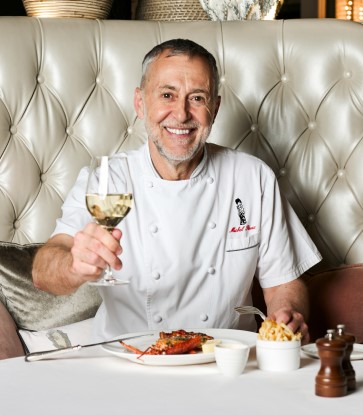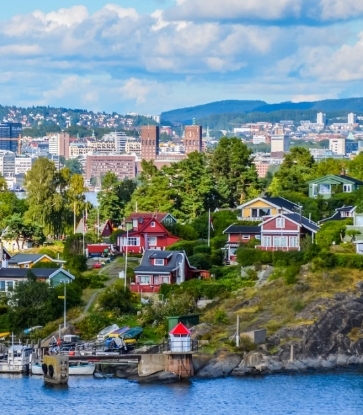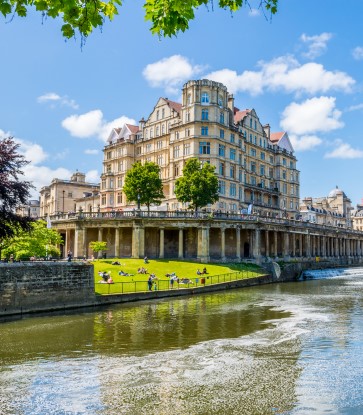So many things in life boil down to questions of geography, and how people eat is a prime example. Whether that is a nomadic tribe moving vast distances to graze their cows or a legendary chef singing the virtues of terroir, geography determines how we eat, full stop. And as sustainability becomes more and more of a motivating factor for restaurants, keeping things as local as possible is a logical choice.
This would be challenging but doable in Bangkok for a Thai or Indian restaurant. But is it possible to make classical French cuisine sustainable in a tropical Asian climate? That is the question posed by J'AIME by Jean-Michel Lorain, one of only two MICHELIN Green Star recipients in Bangkok in the MICHELIN Guide Thailand 2024, opened under the auspices of Chef Jean-Michel Lorain (owner of the two MICHELIN star La Côte Saint-Jacques in Joigny, France). Here, Chefs Amerigo Sesti of Italy and Yoan Martin of France have, over the past few years, been radically transforming one of the city’s most feted French restaurants into something totally new.
Although Sesti puts it a bit more bluntly: “Why is the world so sick that you find a chef in France using lemongrass for the sake of being exotic? In Thailand, why do you need to import? It’s a psychosis.”

It started with Sesti and Martin reading Silo: The Zero Waste Blueprint by Douglas McMaster, chef-owner of London’s pioneering Silo (another Green Star laureate), arguably the world’s most well-known true zero-waste restaurant. This is probably something better seen as a goal rather than a strict requirement, and Sesti is a stickler for this point. “We’re very strict. We cannot say we’re zero waste. We can say we’re mindful. We can say we’re reducing waste. Zero is mathematical. We would not claim anything else for marketing’s sake.”
To Sesti and Martin, it required a complete change in how they thought about their menus. “When you start to restructure the way you conceive your recipes, that is where you reduce. It’s an exercise. In school, we’re not trained to work like this… we’re not told what to do with fish scales… We rethink every step of the recipe, and at the end, there has to be nothing or a byproduct that we can use somewhere else.”
These reuses can range from the obvious and intuitive (vegetable scraps going into a stock, for instance) to the wildly inventive, with plates made from eggshells and kitchen plastics, and those used-up stock vegetables being pressed into paper.
Beyond reducing food waste and plastic use, any French (or Italian, or Japanese…) restaurant in a place like Bangkok is going to have to contend with the fact that a lot of their ingredients necessarily come from different climates, and furthermore, guests are likely to expect lobsters from Brittany, scallops from Hokkaido, and so forth.
“First, we cut out beef,” Sesti says with a smile. “Every single restaurant serves beef. Let’s stop. If we choose to serve it, we serve it to 23,000 people every year. If we don’t have it, they won’t eat it…” While that may seem a heresy in the cuisine that gave the world boeuf bourguignon and steak-frites, alternatives are available.
“We base our recipes on what’s available locally. Giant trevally, pomfret, OK, there are some similarities with Saint-Pierre or turbot. We try to align with what we can get locally, find a product similar to what we can get in Europe, and then use this process to adjust the recipe with local ingredients. We tasted banana blossom, and we cook it like an artichoke. In Thailand, there are 20 or 30 varieties of sugar… if you go to look for glucose that you normally buy, industrially produced and imported. It requires a lot of work because it means that all your bases don’t work anymore. You work in pastry, you change the sugar, the recipe doesn’t work anymore… It requires a lot of R&D.”

But Martin points out that that can also be a source of inspiration. “When we start working with the local sugar, each kind of sugar has a different flavour, some are fruity, some are nutty,” Sesti explains the process. “We’re making a papaya jam, it smells a little like a tomato. Let’s try to adapt it… The next day, you’re using papaya seeds, banana skins, and fish bones.” To say nothing of their “olive oil” made by infusing cocoa nibs.
While the kitchen relies heavily on local ingredients, Sesti and Martin also aim to work with local producers who are themselves inspired by European cuisine, transplanting ideas from France and Italy to the soil and climate of Thailand. These could be stereotypically “Western” vegetables or they could be tricky artisanal goods like wine and cheese. “Maybe it’s not consistent, but you need to give them a chance to grow and develop… maybe in 50 years, they’ll have their own AOC” (referring to the French system of indicating local products). And while it may sound farfetched now, keep in mind it was not long ago that American or Australian wines and cheeses were treated with the same dismissal.
So the two of them have, through careful trial and error, found ways to work sustainably in their local environment and make their cuisine echo the recipes and traditions of France more broadly and Jean-Michel Lorain more specifically. Sesti points out “The opportunity we tried to explain to Lorain, we had to tell him, we’ll need to change all your recipes dramatically, but he understood, because if you want to be sustainable here, you cannot do it with the same products as in Burgundy.”
The result? Even though the ingredients may be Thai in origin and utterly unfamiliar to the average French chef, what Sesti and Martin have created is a cuisine that relies on the creativity of the chefs and pays the deepest respect to the terroir they work in.
And really, what could be more French than that?
Illustration image: © J'AIME by Jean Michel Lorain






















